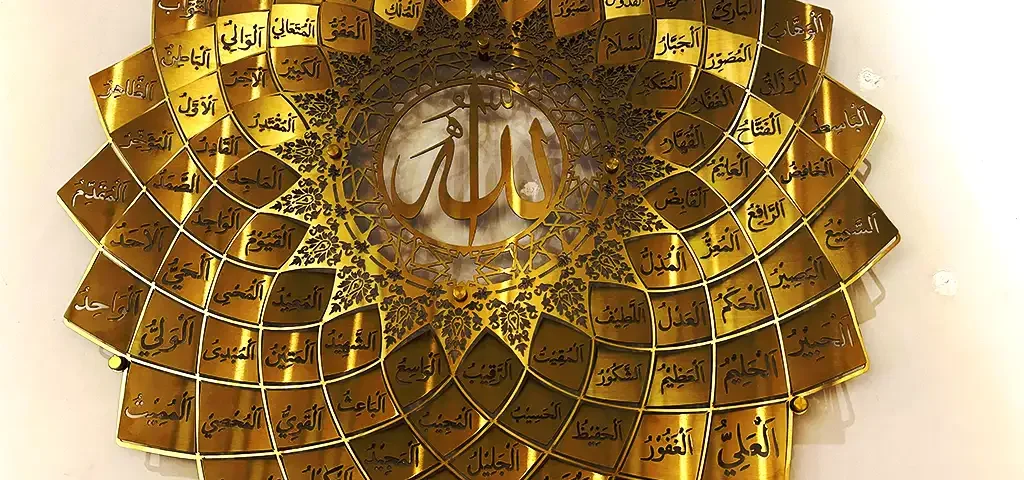Islamic art and calligraphy transcend mere decoration or aesthetic appeal—they embody a profound connection between spirituality and artistic expression. Calligraphy, often referred to as the “geometry of the soul written in ink,” has a uniquely elevated status within Islamic culture. Why? Because it serves as a medium to convey messages of divine beauty, wisdom, and guidance straight from the Qur’an and the many Names of Allah (Asma’ul Husna).
The 99 Names of Allah hold a special place in the hearts of Muslims, shaping both theology and daily life. But they have also inspired centuries of intricate artwork, creating a perfect blend of the divine and the human need to create and beautify.
This blog explores the historical and spiritual significance of Allah’s 99 Names, their artistic representations across cultures, and their continued relevance in the contemporary art world.
The 99 Names of Allah in Islamic Theology and Practice
Central to Islamic belief, the 99 Names of Allah (also known as Asma’ul Husna, meaning “the most beautiful names”) are attributes that describe God’s infinite qualities. Each Name highlights a unique aspect of Allah, such as His mercy (Ar-Rahman), justice (Al-Adl), or wisdom (Al-Hakim). These Names are more than titles—they are tools of remembrance, reflection, and prayer for Muslims worldwide.
The Prophet Muhammad (peace be upon him) said, “Allah has ninety-nine Names, and whoever preserves them (in memory and practice) will enter Paradise” (Sahih Bukhari). This teaching underscores the beauty of these Names as not only descriptors of Allah but as pathways for spiritual growth and connection.
A Journey through History and Traditions

The representation of Allah’s Names in Islamic art has a rich history, dating back to the earliest days of the Islamic empire. While early Muslims avoided figurative representations to maintain the purity of religious art, calligraphy became the main form of expression—a way to elegantly portray divine words while adhering to Islamic principles.
Early Contributions to Calligraphy

The Kufic script, one of the oldest Arabic calligraphy styles, played a major role in early Islamic art. The Names of Allah, often inscribed in geometric forms, adorned the walls of mosques, domes, and ceramic tiles. This style emphasized precision and symmetry, reflecting the perfection and balance inherent in divinity.
Regional Influence on Art
From the intricate scrollwork of Ottoman calligraphy to the vibrant colors of Persian miniature paintings, the artistic representation of Allah’s Names evolved across regions. For example:
The Ottomans favored large, imperial inscriptions. The Name Ar-Rahman was often showcased in mosques to emphasize Allah’s mercy.
Persian art incorporated floral patterns around the Names, symbolizing divine beauty in nature.
Mughal artists fused Arabic calligraphy with Indian artistry, creating dazzling compositions featuring Names like Al-Malik (The King) with an imperial flair.
The Aesthetic and Spiritual Meaning of Allah’s Names

The appeal of Allah’s Names lies in their ability to engage both the aesthetic senses and the soul. Each Name carries profound meanings, inviting Muslims to contemplate Allah’s attributes while deepening their faith.
Key Examples of Names and Their Artistic Depictions
Ar-Rahman (The Most Merciful)
Ar-Rahman symbols of mercy radiate from this Name, often depicted with flowing, soft calligraphic styles and carefully balanced strokes that signify compassion. It is commonly found in mosques’ ornamental inscriptions to remind worshippers of Allah’s boundless mercy.
Al-Khaliq (The Creator)
This Name resonates deeply with artists, as Allah is the ultimate Creator of all things. It is often framed within floral designs or natural motifs, bridging the divine act of creation with human creativity.
Al-Adl (The Just)
To reflect the unshakable fairness of Allah, Al-Adl is typically portrayed in bold, geometric patterns, symbolizing balance and equity. These designs are often found in architecture to inspire societal justice and fairness.
The Power of Tasting Notes in Art and Prayer

Muslims interact with the Names of Allah not only visually but also through spiritual reflection. Each brushstroke of a calligrapher is an act of dhikr (remembrance of Allah), transforming the appreciation of art into a form of worship. When we observe these Names in their artistic context, we are reminded of Allah’s omnipresence in both art and life.
A Contemporary Renaissance in Calligraphy
While the traditions of Islamic calligraphy remain sacred, contemporary Muslim artists are finding new ways to reimagine and present the 99 Names of Allah.
Insights from Today’s Artists
Artists like Haji Noor Deen mix classical scripts with modern interpretations, crafting vibrant visual masterpieces that appeal to both traditionalists and newer generations. Similarly, Dana Awartani explores the relationship between patterns, geometry, and the divine in her contemporary take on Islamic motifs.
Many artists emphasize that creating and displaying the Names of Allah is more than art—it is a deeply personal act of devotion. These pieces invite viewers to connect spiritually while celebrating the beauty of Islamic heritage.
Modern Applications of Allah’s Names
Beyond galleries, the 99 Names of Allah are finding new homes in everyday objects like jewelry, home décor, and even digital design. Muslim calligraphers are also leveraging AI and advanced tools to bring these Names into digital spaces as a form of remembrance and education for global audiences.
A Lasting Legacy for the Soul and the Senses

Islamic art is a living testament to how faith and creativity can intertwine seamlessly. The 99 Names of Allah, with their timeless beauty and spiritual depth, continue to inspire generations of artists and enthusiasts.
Whether through ancient architecture or contemporary digital displays, these Names remind us of Allah’s infinite qualities and the importance of striving toward His attributes in our daily lives.
For those passionate about both faith and art, the world of Islamic calligraphy offers endless avenues for exploration.
If you’re eager to learn more, why not explore the legacy of these sacred Names or even try your hand at creating your own artistic interpretations? The beauty of Allah’s Names belongs to us all, waiting to enrich our lives and spirits.












